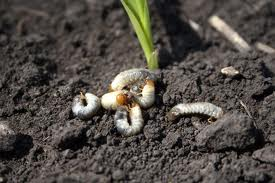
Grubs are ugly little creatures that like to make their homes in our lawns. White grubs in lawns are the larvae stage of common beetles like the June bug and the Black Masked Chafer. These root eating larvae are found throughout Pennsylvania and are a perennial problem in lawns in the Eastern Pa. Because they feed on the roots, you can’t always tell they are there until the damage is done. We generally don’t see damage from grubs until the end of August or, or beginning of September.
There is a small window of time at the end of July and the beginning of August when grubs are most easily killed. This is the time of year that the grubs emerge from their eggs and burrow up into the top layer of soil where they eat the roots of the grass. They are easiest to kill in this early stage of development because they are young. In early fall, the grubs will begin to burrow four to eight inches into the soil away from the cold. They will return older and hardier in the spring and will cause more damage then. You want to get your grub treatment down by the end of July or early August to be the most effective.
How Do You Know if Your Berks County Lawn Has Grubs?
If you notice brown patches in your lawn that look a lot like drought stress, you may have grubs. Because the grubs feed on the roots, the grass begins to die and the ground will feel soft or spongy. The green grass next to the damaged areas may lift up just like carpet.
You can check to see if you have grubs by digging up an area that’s showing signs of grass browning. Dig a one foot by one foot area of your lawn to just below the roots. Pull back the turf in these suspect areas. Particularly the marginal areas where brown grass meets green grass. Look for grubs there. Usually a population of about 6 or more grubs per square foot will lead to browning of the lawn.
Another sign of grubs is damage from skunks and raccoons digging up lawns in search of grubs to eat. This usually happens at night. Moles may or may not be feeding on grubs so are not a reliable indicator of grub problems.




